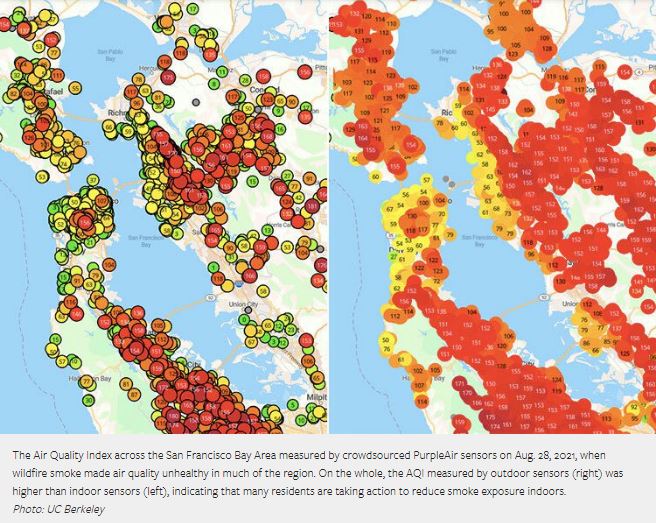How does the amount of oxygen in the air affect us?
How does the amount of oxygen in the air affect us?
We mostly take air for granted. It’s a (boring) mixture of 78 percent nitrogen and 20.9 percent oxygen with small amounts of other gasses such as carbon dioxide, neon, and hydrogen. (10 Interesting Things About Air) Even though the news headlines seem to revolve around increasing carbon dioxide, let’s look at the gas humans are most in need of: oxygen.
The majority of the world’s oxygen levels are the same: 20.9% if the humidity is 0%. Water vapor in the air displaces oxygen, and oxygen can go down to 20.1% if the relative humidity is 100%. This holds true at sea level and high altitude, where the air is said to be “thinner”. At high altitude, the percentage of oxygen in the air is the same, 20.9%. However, lower pressure of the atmosphere causes all molecules of air to spread out. That means you get less oxygen in every breath you take, compared to sea level. (Living in Thin Air)
According to scientists, oxygen levels in the atmosphere in prehistoric times averaged around 30% to 35%, compared to only 21% today – and that the levels are even less in densely populated, polluted city centers and industrial complexes, perhaps only 15 % or lower. (The Oxygen Crisis) Fifteen percent sounds extreme, first of all because OSHA has defined atmospheric oxygen concentration below 19.5 percent to be unsafe. We can only take 19.5% as a guideline, because oxygen in our blood is measured in partial pressure, which may vary slightly according to altitude and the CO2 our bodies are attempting to expel. In general when figuring in humidity, there’s a margin between normal and unsafe of only 1.3%! And, in populated areas, this margin is getting even smaller.
A 2021 study showed that oxygen deficiency can happen in large cities due to a number of factors: increased combustion in vehicles and factories consuming oxygen, lack of green space restricting oxygen production or replenishment, and stalling weather patterns that can stop the flow of fresh air into the city. The study correlated 391 global large cities (with a population of more than 1 million people) using the oxygen index (OI), which is the ratio of oxygen consumption to oxygen production. Results showed that the global urban areas, occupying only 3.8% of the global land surface, accounted for 39% (14.3 ± 1.5 Gt/yr) of the global terrestrial oxygen consumption during 2001−2015. It was estimated that 75% of cities with a population more than 5 million had an OI of greater than 100. Also, cities with larger OI values were correlated with more frequent heatwaves and severe water withdrawals. In fact, oxygen in large cities has been declining by 4 ppm per year since the 1980’s, and that rate is actually accelerating.
When the oxygen in air gets too low, as in high altitudes or confined spaces, the body can enter a state of hypoxia, where low levels of oxygen in your body tissues causes symptoms like confusion, restlessness, difficulty breathing, rapid heart rate, and bluish skin. (Hypoxia) Unfortunately, many people in mountainous regions around the world suffer from hypoxia and other effects of high-altitude, which are together called Chronic Mountain Sickness (CMS).
To restore proper tissue function, you’ve got to get more oxygen. Getting more oxygen in your lungs has a long-recognized stimulant effect, allowing you to focus, concentrate and generally perform better mentally. In your lungs, more oxygen causes the blood vessels in your lungs to dilate, which improves cleansing and tissue repair within them, and helps them exchange gasses more easily. In the rest of your body, more oxygen lowers blood pressure and heart rate (your heart doesn’t have to pump as much blood to get the correct amount of oxygen), your tissues heal faster, and digestion is improved. (Surprising Health Benefits of Getting Fresh Air)
Whether it’s increasing levels of carbon dioxide (check our article here) or decreasing levels of oxygen, our bodies are not made to live in cities or houses without adequate ventilation! Ventilation restores oxygen levels to a safe level above 20% and flushes out harmful gasses like carbon dioxide, radon and VOCs. It’s interesting to note the differences between fresh air and exhaled air:
Fresh Air | Exhaled Air | |
Nitrogen | 78% | 78% |
Oxygen | 21% | 17% |
Other gases | 1% | 1% |
Carbon dioxide | 0.04% | 4% |
(The composition of inhaled and exhaled air. What should and shouldn’t contain?)
A note on rescue breathing: although 17% oxygen is less than the OSHA safety minimum of 19.5%, it is more oxygen than unconscious victims who are not breathing are getting (0%), so rescue breathing does help to save lives. The problem is that anytime we are conscious (breathing on our own), we should be getting oxygen levels at close to fresh air levels (21%)!
Unless you live in a major city during a heat wave as described above, low oxygen levels in our air at home shouldn’t be a cause for worry. Why? Because even if you lived in a sealed room for 12 days, you would die of carbon dioxide poisoning before running out of oxygen. Thus, carbon dioxide levels are the greater concern, and more so if your home is really well sealed. Note that furnaces and gas stoves require oxygen to burn their fuel. If you operate a furnace or gas stove in a space that’s not well-ventilated, you’re going to get high levels of carbon dioxide first, and when the oxygen level drops enough to cause the furnace to have incomplete combustion, carbon monoxide is produced. There is a simple fix for this: ventilate the space continuously, and install CO and CO2 monitor(s).
There may be several other scenarios where oxygen concentration in your home suffers, and these are real, life-threatening situations.
If you live in the mountains, you know that although the percentage of oxygen in the air is the same, the same volume that you breathe in contains less oxygen than at sea-level. Our bodies compensate for the lower oxygen by increasing heart rate and respiration rate in order to cycle more air through our lungs. Athletes sometimes train at high altitudes to gain “an edge” while competing at sea level.
Fire requires at least 16% oxygen to continue to burn. This is not a problem for most wildfires; as the air within a wildfire heats up dramatically, fresh air is sucked from surrounding areas. If you live in an area prone to wildfires, you may experience high winds bringing fresh air–until the wind changes and smoke is the major problem. In this case, smoke inhalation is deadly because of extreme heat of the smoke, oxygen depletion (hypoxia), and inhalation of noxious gasses carbon monoxide (CO), cyanide or hydrogen cyanide (CN or HCN), phosgene, ammonia, sulfur dioxide, hydrogen sulfide (H2S), formaldehyde, and acrylonitriles. (Smoke Inhalation Injury: Etiopathogenesis, Diagnosis, and Management) In this case, the presence of toxic gasses may be more life-threatening than low oxygen.
As we mentioned above, living in a city during extreme heat or even inversion (many times this occurs during the winter), oxygen at ground level becomes depleted and this layer becomes more polluted and less oxygenated.
Each of these situations can become life-threatening. If you find yourself living in risk of any of them, the first step would be to monitor oxygen (and other pollutants for situations 2 and 3). Unfortunately, most web-enabled monitors do not have oxygen sensors. In fact, the only multi-sensor home monitor I could find that included oxygen is by Airovita, which is made in Europe and not sold in the US. Don’t let this “hole” in the market stop you from being informed, however; handheld meters like this one ($100) that measure O2, CO, H2S, and explosive gasses are accessible so that you can be aware of how the atmosphere outside is affecting your home’s air. In the case of high-altitude air, however, be aware that oxygen levels will register as “normal” (20-21%) but because of the low atmospheric pressure, you still may have trouble breathing!
Unfortunately, making your air more breathable costs money. The Washington Post notes that during wildfires, wealthier families flee smoky areas, staying in second homes or renting expensive hotels or vacation residences. Not all families can afford air purifiers, which start at about $200 and clean only one room. During frequent power outages that happen during fire season, only wealthier families that can afford expensive backup generators will still be able to run their purifiers. Nonetheless, here are some solutions for making life safer and more comfortable:
If you desire to add more oxygen to any room in the home (especially the bedroom, where your body repairs itself while you sleep), then companies like ACT (Altitude Control Technology) offer “altitude control”, meaning that with their controllers, ventilation and oxygen generators, you can change the atmosphere of that room to mimic living at a lower altitude. Athletes can even use the system to change their workout room to a higher “altitude”. Selecting a lower altitude creates an artificial “pressure” so that your lungs will receive more oxygen with less work. Their equipment also includes particulate air filters to eliminate dust, viruses, bacteria, and fine particles as small as .3 microns to keep the air pure. Truly, this system is the gold standard in creating the desired altitude, because of its oxygen machines, control system and custom designs for each room. Alarms notify the user(s) of any unsafe conditions, and the air separation units are under low pressure.
Since toxic gasses and particulates can be even more likely than low oxygen during a wildfire event, it’s best to start using air quality monitors to plan your days during these events. When air outside is bad, closing up your home and using air filters can make it better. As shown in the graphic below, indoor air sensors (left) are better than outdoor air sensors (right). (How much wildfire smoke is infiltrating our homes?) Also, check out our article on how to prepare for wildfires and keep your air quality safe.
Ultra-filtration and oxygen generation technology can be adapted to any shelter, provided you have the budget! “Bunkers” are not what they used to be. Nowadays the mega-wealthy have underground swimming pools, gardens, and entertainment to escape whatever is happening above-ground. Some developers are also acquiring decommissioned military bunkers and missile silos built by the United States or Soviet governments – sites that would cost hundreds of millions of dollars to build today. The fortified structures are designed to withstand a nuclear strike and come equipped with power systems, water purification systems, blast valves, and Nuclear-Biological-Chemical (NBC) air filtration. (Billionaire bunkers: How the 1% are preparing for the apocalypse)
So, although oxygen depletion rarely happens at lower altitudes, if you have concern about it, make sure to measure it and then take action. As John F. Kennedy said, “The time to repair the roof is when the sun is shining,” or in our case, the time to prepare our air is now! Don’t wait for that extreme event to buy an air filter, learn how to control your home’s ventilation, or search for a getaway spot, because that’s what the majority of people will be doing. Now’s the time to get ahead of the curve!
Photo by Jason Hogan on Unsplash


